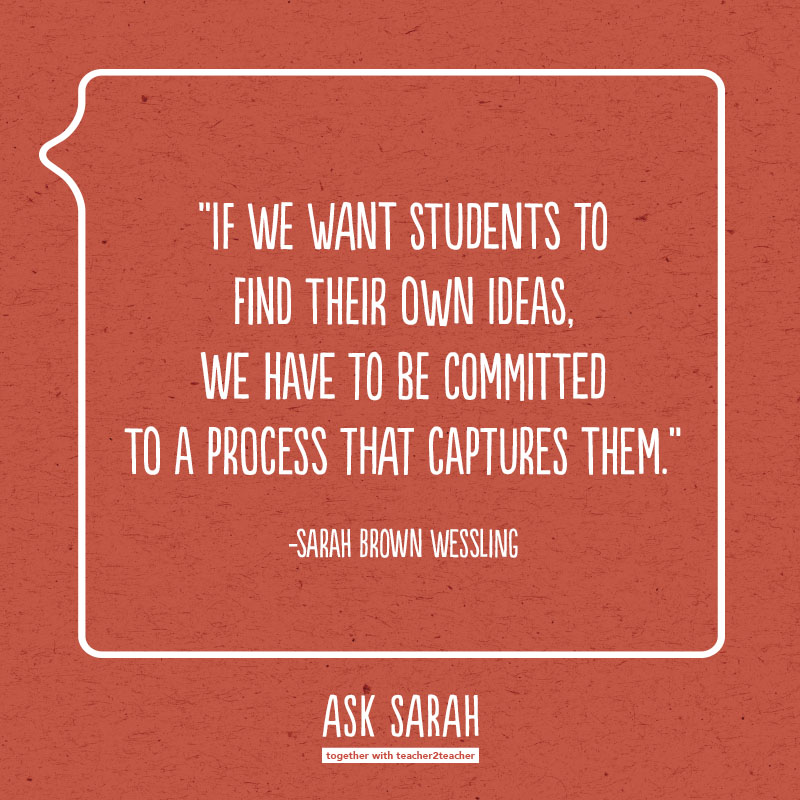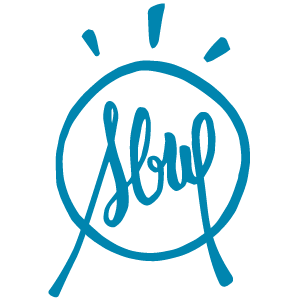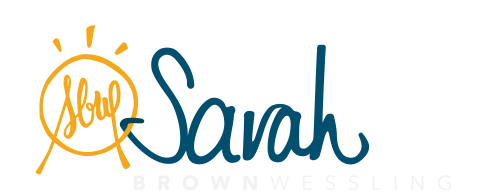
Dear Sarah,
Hey super lady! My co-worker and I are hoping to find new ways to bring out student ideas when they’re writing. What do you do or what do you use? Do you have any professional development suggestions or resources to point us toward? Help!
Sincerely,
Bringing Out Student Ideas
Dear Bringing Out Student Ideas,
Each year before I start a new school year, I take some time to decide what my personal teaching goal will be. This isn’t usually my “official” goal, but the one I want to live by, the one I think will keep my teaching centered throughout the year. This year, I told myself: “No phony writing assignments.” In other words, have them write letters and proposals, profiles and case studies. And when we write the academic essay, be sure they understand this is what we write for school, but we’d all be hard-pressed to find writing outside of school that stacks five paragraphs on top of each other with predictable topic sentences, rhetorical questions and re-stated thesis statements.
Your answer resides in what I can tell you already know: their best ideas are already inside them. I think it’s why you used the phrase “bringing out” because you recognize our writers are ready to develop their ideas, to find their voices. It’s the confrontation we must have with ourselves: if our students already have ideas, but aren’t showing them, what are we doing to inhibit them?
It can be really tough to discover your ideas within the constraints of highly structured academic essays. I know this because just this week I sat down to do one of the assignments I’d given to my students and was absolutely stuck. I couldn’t write the darn thing within the structure I had assigned. If we want students to find their own ideas, we have to be committed to a process that captures them.
Don’t misunderstand me. My students write traditional academic papers too. But it’s not all we do. Whether it’s an academic paper or a another genre, we have to invest in a process to bring out their ideas. Here are some of the ways we plunge into that process.
- We don’t write in isolation. Our writing is born from responses to all kinds of texts, speeches, articles, and discussions.
- We talk. A lot. Writers often don’t know where to start until they’ve been able to talk about their ideas, to see how they emerge and change.
- We work from their questions whenever possible. This means there may be 30 different paper topics in one class period, but it also means they will probably be more invested in the writing that emerges from their own curiosity.
- We pitch ideas and get feedback on our thinking early in the process. We try to vet our ideas, learn how to look for gaps in our thinking, abandon and build.
- We work really hard to create audience that isn’t me. It’s one of the quickest ways to damper their ideas. Something clenches their process when writing for a grade becomes their main motivation. I can’t alleviate that entirely, but I can lessen it when we shift the audience.
- We create authentic purpose for writing, which is often born out of the audience we’re writing for or the resources that inspire the writing experiences that find their way into our classroom.
You asked about resources and I have to be honest, my best resources most often come from the writers I meet as a result of my own reading habits. I’m always looking for the next “non-phony” writing experience to bring to class. It’s our version of NPR’s “You Have to Read this Book” or Outside Magazine’s profiles. It’s the TEDTalk or the Shark Tank persuasive pitch.
Bringing out student ideas reminds me of Doris Lessing’s quote: “That is what learning is. Realizing something you’ve always known, but in a new way.” It’s audience and invitation. It’s purpose and process. It’s choice and patience. It’s offering the space of authentic experiences where they have room to find themselves.
Teach openly,
With Teacher2Teacher




https://interpharm.pro/# buy prescription drugs on line
canadian pharacy – interpharm.pro Providing international caliber services consistently.
https://onlineapotheke.tech/# versandapotheke deutschland
https://pharmacieenligne.icu/# pharmacie ouverte 24/24
Pharmacie en ligne livraison rapide: acheter medicament a l etranger sans ordonnance
Pharmacie en ligne livraison rapide – pharmacie ouverte 24/24
Acheter kamagra site fiable
canada drugs reviews: canadian pharmacy oxycodone – buy prescription drugs from canada cheap
mexico pharmacies prescription drugs: buying prescription drugs in mexico – best online pharmacies in mexico
mexico pharmacies prescription drugs: mexico drug stores pharmacies – medication from mexico pharmacy
Their commitment to international standards is evident. mexican online pharmacies prescription drugs: best online pharmacies in mexico – mexican rx online
indian pharmacy online: Online medicine order – top 10 online pharmacy in india
mexican drugstore online: mexican pharmaceuticals online – buying prescription drugs in mexico online
Their international supply chain ensures no medication shortages. indian pharmacy: best india pharmacy – buy medicines online in india
Their worldwide delivery system is impeccable. best canadian pharmacy online: canadapharmacyonline com – canadian medications
reputable mexican pharmacies online: buying prescription drugs in mexico online – mexican border pharmacies shipping to usa
They bridge the gap between countries with their service. medication from mexico pharmacy: buying prescription drugs in mexico online – reputable mexican pharmacies online
mexican pharmaceuticals online: best online pharmacies in mexico – reputable mexican pharmacies online
п»їMedicament prescribing information. http://edpillsotc.store/# erection pills that work
best ed pills at gnc buy ed pills online ed pills that work
A place where customer health is the top priority. https://azithromycinotc.store/# zithromax 500 mg lowest price pharmacy online
A beacon of reliability and trust. http://azithromycinotc.store/# zithromax 500 mg
They have strong partnerships with pharmacies around the world. doxycycline 100mg capsule sale: buy doxycycline online – doxycycline 150 mg
ed remedies Instant erection pills ed treatment review
They provide global solutions to local health challenges. https://indianpharmacy.life/# indian pharmacy online
Read information now. https://indianpharmacy.life/# world pharmacy india
pharmacies in mexico that ship to usa best online pharmacy in Mexico buying prescription drugs in mexico
Commonly Used Drugs Charts. http://indianpharmacy.life/# india pharmacy mail order
A trusted partner for patients worldwide. https://mexicanpharmacy.site/# mexican pharmaceuticals online
canadian pharmacy world canadian pharmacy without prescription save on pharmacy
A one-stop-shop for all my health needs. https://drugsotc.pro/# mexico pharmacy order online
purple pharmacy mexico price list Mexico pharmacy online mexican mail order pharmacies
They bridge the gap between countries with their service. http://mexicanpharmacy.site/# mexican mail order pharmacies
They always keep my medication history well-organized. http://gabapentin.world/# order neurontin online
neurontin 100mg tab: neurontin 300mg caps – brand name neurontin price
us pharmacy online: online pharmacies no prescription usa – canadian pharmacy no scripts
They provide global solutions to local health challenges. http://internationalpharmacy.pro/# legit canadian pharmacy
mexican drugstore online : pharmacy in mexico – mexican online pharmacies prescription drugs
mexico drug stores pharmacies and mexico pharmacy online – mexico drug stores pharmacies
buying prescription drugs in mexico online – mexico pharmacy online – mexican rx online
reputable mexican pharmacies online or mexican drugstore – purple pharmacy mexico price list
buying prescription drugs in mexico online or mexican pharmacies – buying from online mexican pharmacy
ivermectin 200: stromectol order online – minocycline 50 mg tablets for humans for sale
https://canadapharmacy24.pro/# canadian pharmacy no scripts
ivermectin 3 mg: stromectol order online – ivermectin 0.5 lotion
https://stromectol24.pro/# minocycline 100mg without a doctor
india online pharmacy: mail order pharmacy india – online pharmacy india
https://indiapharmacy24.pro/# indian pharmacy
minocycline 100mg over the counter: stromectol ivermectin buy – where to buy ivermectin
http://canadapharmacy24.pro/# canadian drugstore online
https://valtrex.auction/# valtrex generic in mexico
https://plavix.guru/# Plavix generic price
get cheap mobic tablets: Mobic meloxicam best price – can you buy mobic pill
paxlovid buy: buy paxlovid online – Paxlovid buy online
http://mobic.icu/# mobic pills
ivermectin iv: ivermectin lotion – minocycline 50mg tablets for human
https://stromectol.icu/# stromectol online canada
minocycline capsulas: minocycline 50 mg acne – minocycline 100 mg tablets online
where can i get generic mobic for sale: buy anti-inflammatory drug – how can i get mobic without prescription
Kamagra 100mg super kamagra buy Kamagra
cheap kamagra: Kamagra tablets – Kamagra 100mg
http://cialis.foundation/# Buy Tadalafil 5mg
Моя кофемашина вышла из строя. На радость обратился за услугой ремонт кофеварок delonghi в москве мастеров по восстановлению таких устройств.
Быстро, специалист приехал и устранил проблему. Вернуть работоспособность её ему понадобилось тридцать минут. Так, моя кофемашина ожила, как из магазина.
http://cialis.foundation/# Cheap Cialis
http://kamagra.icu/# cheap kamagra
buy Kamagra Kamagra 100mg buy kamagra online usa
http://kamagra.icu/# cheap kamagra
http://viagra.eus/# buy Viagra over the counter
generic sildenafil Viagra Tablet price Sildenafil 100mg price
buy Levitra over the counter Buy Vardenafil online Levitra 20 mg for sale
http://kamagra.icu/# Kamagra Oral Jelly
http://kamagra.icu/# п»їkamagra
https://kamagra.icu/# super kamagra
Kamagra 100mg price Kamagra 100mg price buy kamagra online usa
https://viagra.eus/# viagra without prescription
https://kamagra.icu/# Kamagra tablets
Buy Vardenafil 20mg online Buy Vardenafil 20mg Buy generic Levitra online
https://levitra.eus/# Buy Vardenafil online
http://viagra.eus/# sildenafil 50 mg price
Мы с мужем долго планировали ремонт на кухне, но все время что-то мешало. Наконец, у нас появилось свободное время, но не хватало денег. И тут я нашла решение на сайте credit-info24.ru, который собрал все МФО в одном месте. Оформила взять микрозайм на карту срочно без отказа, и теперь мы наконец-то начали долгожданный ремонт.
cheapest viagra Viagra online price sildenafil online
mexican drugstore online: purple pharmacy mexico price list – mexico pharmacies prescription drugs mexicanpharmacy.company
https://mexicanpharmacy.company/# medicine in mexico pharmacies mexicanpharmacy.company
medicine in mexico pharmacies: mexico pharmacies prescription drugs – buying from online mexican pharmacy mexicanpharmacy.company
best online canadian pharmacy: ordering drugs from canada – online canadian pharmacy canadapharmacy.guru
https://mexicanpharmacy.company/# mexican border pharmacies shipping to usa mexicanpharmacy.company
escrow pharmacy canada: canadian king pharmacy – best mail order pharmacy canada canadapharmacy.guru
canadian pharmacy drugs online: canadian pharmacies compare – reputable canadian pharmacy canadapharmacy.guru
http://mexicanpharmacy.company/# buying from online mexican pharmacy mexicanpharmacy.company
canadian pharmacy online: canadian pharmacy review – canada drugs online review canadapharmacy.guru
mexico drug stores pharmacies: mexican drugstore online – medication from mexico pharmacy mexicanpharmacy.company
https://canadapharmacy.guru/# canadian 24 hour pharmacy canadapharmacy.guru
https://canadapharmacy.guru/# legal to buy prescription drugs from canada canadapharmacy.guru
reddit canadian pharmacy: canadianpharmacymeds – canadian pharmacy prices canadapharmacy.guru
mexican mail order pharmacies: reputable mexican pharmacies online – mexico pharmacy mexicanpharmacy.company
indian pharmacy paypal: buy medicines online in india – top 10 online pharmacy in india indiapharmacy.pro
https://indiapharmacy.pro/# Online medicine order indiapharmacy.pro
http://mexicanpharmacy.company/# mexico drug stores pharmacies mexicanpharmacy.company
«СК Сити Строй”: преобразим вашу квартиру вместе
Ищете мастеров, которые смогут взять на себя весь процесс ремонта вашей квартиры? ООО «СК СИТИ СТРОЙ» предлагает услугу ремонт квартир под ключ, где каждый этап работ выполняется под строгим контролем наших специалистов. Наш подход гарантирует, что весь процесс будет прозрачным и без стрессовым для вас.
На remont-siti.ru вы найдете полное портфолио наших работ и сможете убедиться в высоком качестве исполнения. Мы ценим время наших клиентов и предлагаем оптимальные сроки реализации проектов. Наш офис ждет вас по адресу: 127055 г. Москва, ул. Новослободская, д. 20, к. 27, оф. 6. Доверьте ремонт профессионалам, и ваша квартира засияет новыми красками!
http://canadapharmacy.guru/# best canadian pharmacy canadapharmacy.guru
reputable indian pharmacies: indian pharmacy paypal – top 10 online pharmacy in india indiapharmacy.pro
buying prescription drugs in mexico online: mexico drug stores pharmacies – mexican pharmacy mexicanpharmacy.company
https://mexicanpharmacy.company/# mexican pharmaceuticals online mexicanpharmacy.company
canadian pharmacy prices: canadian neighbor pharmacy – canadian family pharmacy canadapharmacy.guru
mexico pharmacy: mexican online pharmacies prescription drugs – mexican pharmaceuticals online mexicanpharmacy.company
Online medicine home delivery: india pharmacy – п»їlegitimate online pharmacies india indiapharmacy.pro
https://canadapharmacy.guru/# canadian online pharmacy canadapharmacy.guru
https://canadapharmacy.guru/# canadian pharmacy prices canadapharmacy.guru
Online medicine home delivery: best india pharmacy – india pharmacy indiapharmacy.pro
canadian pharmacy sarasota: my canadian pharmacy rx – canadian valley pharmacy canadapharmacy.guru
http://mexicanpharmacy.company/# mexican mail order pharmacies mexicanpharmacy.company
reputable indian online pharmacy: best india pharmacy – indian pharmacies safe indiapharmacy.pro
https://mexicanpharmacy.company/# mexican online pharmacies prescription drugs mexicanpharmacy.company
doxycycline hyc: doxycycline prices – buy doxycycline online without prescription
http://clomid.sbs/# where buy generic clomid
cheap doxycycline online: buy cheap doxycycline online – doxycycline vibramycin
http://doxycycline.sbs/# doxycycline 150 mg
amoxicillin online pharmacy: amoxicillin 30 capsules price – amoxicillin 500 mg
https://clomid.sbs/# where to get clomid prices
http://doxycycline.sbs/# where can i get doxycycline
average cost of generic prednisone [url=https://prednisone.digital/#]prednisone 10 tablet[/url] prednisone online australia
https://clomid.sbs/# can i order clomid
online pharmacy india: Online medicine home delivery – Online medicine order
http://edpills.icu/# п»їerectile dysfunction medication
buying prescription drugs in mexico online [url=http://mexicopharm.shop/#]buying prescription drugs in mexico online[/url] mexican mail order pharmacies
http://mexicopharm.shop/# mexican rx online
canadian online pharmacy reviews: best canadian pharmacy to order from – canadian pharmacy tampa
https://edpills.icu/# male ed drugs
buying ed pills online: п»їerectile dysfunction medication – non prescription ed drugs
http://canadapharm.top/# canadian online drugs
prescription without a doctor’s prescription [url=http://withoutprescription.guru/#]tadalafil without a doctor’s prescription[/url] best non prescription ed pills
http://indiapharm.guru/# pharmacy website india
buy prescription drugs online without: ed meds online without doctor prescription – prescription drugs without doctor approval
https://indiapharm.guru/# indianpharmacy com
buying from online mexican pharmacy [url=https://mexicopharm.shop/#]best online pharmacies in mexico[/url] pharmacies in mexico that ship to usa
http://canadapharm.top/# canada pharmacy online
best online pharmacies in mexico: medicine in mexico pharmacies – best online pharmacies in mexico
http://edpills.icu/# medicine for impotence
canadian pharmacy 365 [url=http://canadapharm.top/#]Accredited Canadian and International Online Pharmacies[/url] canada discount pharmacy
http://mexicopharm.shop/# mexican rx online
non prescription erection pills: non prescription ed pills – prescription drugs
https://edpills.icu/# pills for ed
non prescription ed drugs: real cialis without a doctor’s prescription – non prescription ed pills
http://edpills.icu/# generic ed pills
ed drugs [url=https://edpills.icu/#]best ed pills[/url] best ed pills at gnc
safe canadian pharmacy: Certified Canadian Pharmacy – canadian pharmacy cheap
https://mexicopharm.shop/# mexico drug stores pharmacies
clomid no prescription: how to get generic clomid without insurance – cost clomid without insurance
http://indiapharm.guru/# india pharmacy
best pill for ed [url=https://edpills.icu/#]erectile dysfunction medicines[/url] best male enhancement pills
safe canadian pharmacy: Accredited Canadian and International Online Pharmacies – canadian world pharmacy
http://withoutprescription.guru/# prescription drugs online without doctor
https://tadalafil.trade/# generic tadalafil canada
http://levitra.icu/# п»їLevitra price
Kamagra 100mg price [url=http://kamagra.team/#]super kamagra[/url] cheap kamagra
sildenafil 50 mg buy online price: sildenafil 20 mg tablets online – buy online sildenafil citrate
https://tadalafil.trade/# cost of tadalafil
medicine for impotence [url=https://edpills.monster/#]non prescription erection pills[/url] cheapest ed pills online
Levitra 10 mg best price: Buy Vardenafil 20mg online – п»їLevitra price
https://kamagra.team/# Kamagra 100mg price
https://edpills.monster/# top rated ed pills
buy tadalafil over the counter: tadalafil price uk – tadalafil 5mg in india
Cheap Levitra online [url=https://levitra.icu/#]Cheap Levitra online[/url] Buy Vardenafil online
http://kamagra.team/# Kamagra 100mg
Kamagra 100mg price: Kamagra 100mg price – Kamagra 100mg
price of sildenafil [url=http://sildenafil.win/#]sildenafil price in india[/url] sildenafil no prescription free shipping
Vardenafil price: Levitra online pharmacy – Buy Vardenafil 20mg
http://levitra.icu/# Cheap Levitra online
Generic Levitra 20mg: Vardenafil online prescription – buy Levitra over the counter
https://tadalafil.trade/# tadalafil tablets 20 mg online
amoxicillin 1000 mg capsule [url=https://amoxicillin.best/#]amoxil for sale[/url] amoxicillin 500mg price in canada
where can i buy cipro online: buy ciprofloxacin online – buy cipro
buy zithromax without presc: zithromax z-pak – zithromax order online uk
https://ciprofloxacin.men/# buy ciprofloxacin
cipro online no prescription in the usa [url=http://ciprofloxacin.men/#]Ciprofloxacin online prescription[/url] п»їcipro generic
buy ciprofloxacin over the counter: Get cheapest Ciprofloxacin online – buy ciprofloxacin
where can i buy zithromax medicine: zithromax antibiotic without prescription – zithromax purchase online
https://lisinopril.auction/# benicar lisinopril
generic zithromax azithromycin [url=http://azithromycin.bar/#]zithromax z-pak[/url] zithromax buy online
amoxicillin price canada: purchase amoxicillin online – generic amoxicillin
http://doxycycline.forum/# doxycycline capsules india
where can i buy amoxicillin over the counter uk [url=https://amoxicillin.best/#]buy amoxil[/url] amoxicillin online purchase
zithromax prescription online: buy zithromax canada – how to get zithromax online
amoxicillin generic: amoxil for sale – amoxicillin 500mg no prescription
http://amoxicillin.best/# buy amoxicillin 500mg
zithromax online [url=https://azithromycin.bar/#]can you buy zithromax over the counter in canada[/url] zithromax buy online
lisinopril cost uk: buy lisinopril – lisinopril price without insurance
http://azithromycin.bar/# buy zithromax 1000mg online
amoxicillin 250 mg [url=https://amoxicillin.best/#]purchase amoxicillin online[/url] amoxicillin order online no prescription
zithromax online paypal: zithromax z-pak – buy zithromax online with mastercard
cost for 2 mg lisinopril: prescription for lisinopril – cost of lisinopril 2.5 mg
canadian pharmacy reviews: canadapharmacyonline com – legitimate canadian pharmacy online
compare prescription drug prices [url=https://buydrugsonline.top/#]online meds[/url] aarp recommended canadian pharmacies
perscription drugs without perscription: Mail order pharmacy – best 10 online canadian pharmacies
https://buydrugsonline.top/# prescription drugs online
family discount pharmacy: online pharmacy no prescription – canadian pharmacy prices
top 10 online pharmacy in india: п»їlegitimate online pharmacies india – indian pharmacies safe
safe online pharmacy [url=https://buydrugsonline.top/#]online meds[/url] canadian prescription costs
http://canadiandrugs.store/# best rated canadian pharmacy
testosterone canadian pharmacy: buy drugs online – list of approved canadian pharmacies
п»їbest mexican online pharmacies: mexican pharmacy – purple pharmacy mexico price list
https://gabapentin.life/# 2000 mg neurontin
neurontin price [url=http://gabapentin.life/#]generic gabapentin[/url] neurontin 100mg cap
paxlovid india: Buy Paxlovid privately – paxlovid pill
https://wellbutrin.rest/# how to get wellbutrin prescription
cheap ventolin inhaler: buy Ventolin inhaler – ventolin pharmacy
http://gabapentin.life/# neurontin 100mg caps
zyban wellbutrin: buy wellbutrin – order wellbutrin online uk
https://clomid.club/# buying cheap clomid no prescription
where to buy wellbutrin sr: Buy Wellbutrin XL 300 mg online – wellbutrin 540mg
https://claritin.icu/# ventolin tablets australia